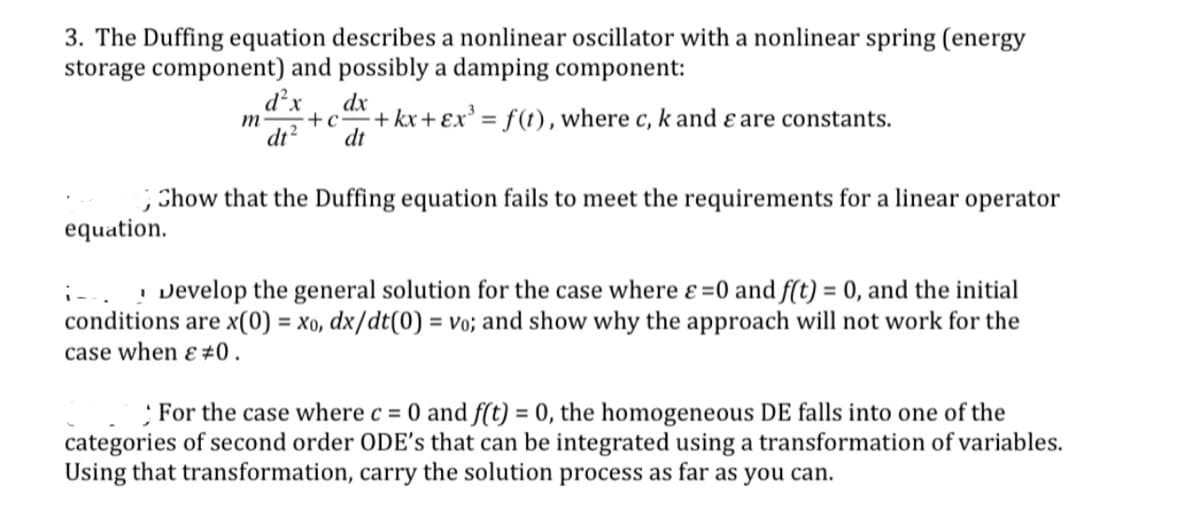3. The Duffing equation describes a nonlinear oscillator with a nonlinear spring (energy storage component) and possibly a damping component: d²x dx +c +kx+Ex³ = f(t), where c, k and & are constants. 2 dt dt ; Chow that the Duffing equation fails to meet the requirements for a linear operator equation. ;. • Develop the general solution for the case where & =0 and f(t) = 0, and the initial conditions are x(0) = xo, dx/dt(0) = vo; and show why the approach will not work for the case when & #0. For the case where c = 0 and f(t) = 0, the homogeneous DE falls into one of the categories of second order ODE's that can be integrated using a transformation of variables. Using that transformation, carry the solution process as far as you can.
3. The Duffing equation describes a nonlinear oscillator with a nonlinear spring (energy storage component) and possibly a damping component: d²x dx +c +kx+Ex³ = f(t), where c, k and & are constants. 2 dt dt ; Chow that the Duffing equation fails to meet the requirements for a linear operator equation. ;. • Develop the general solution for the case where & =0 and f(t) = 0, and the initial conditions are x(0) = xo, dx/dt(0) = vo; and show why the approach will not work for the case when & #0. For the case where c = 0 and f(t) = 0, the homogeneous DE falls into one of the categories of second order ODE's that can be integrated using a transformation of variables. Using that transformation, carry the solution process as far as you can.
Elements Of Electromagnetics
7th Edition
ISBN:9780190698614
Author:Sadiku, Matthew N. O.
Publisher:Sadiku, Matthew N. O.
ChapterMA: Math Assessment
Section: Chapter Questions
Problem 1.1MA
Related questions
Question

Transcribed Image Text:3. The Duffing equation describes a nonlinear oscillator with a nonlinear spring (energy
storage component) and possibly a damping component:
equation.
m
i
d²x
dt2 2
+c
dx
+ kx + εx³ = f(t), where c, k and & are constants.
dt
Chow that the Duffing equation fails to meet the requirements for a linear operator
Develop the general solution for the case where & =0 and f(t) = 0, and the initial
conditions are x(0) = xo, dx/dt(0) = vo; and show why the approach will not work for the
case when �.
For the case where c = 0 and f(t) = 0, the homogeneous DE falls into one of the
categories of second order ODE's that can be integrated using a transformation of variables.
Using that transformation, carry the solution process as far as you can.
Expert Solution
This question has been solved!
Explore an expertly crafted, step-by-step solution for a thorough understanding of key concepts.
This is a popular solution!
Trending now
This is a popular solution!
Step by step
Solved in 4 steps

Recommended textbooks for you

Elements Of Electromagnetics
Mechanical Engineering
ISBN:
9780190698614
Author:
Sadiku, Matthew N. O.
Publisher:
Oxford University Press

Mechanics of Materials (10th Edition)
Mechanical Engineering
ISBN:
9780134319650
Author:
Russell C. Hibbeler
Publisher:
PEARSON

Thermodynamics: An Engineering Approach
Mechanical Engineering
ISBN:
9781259822674
Author:
Yunus A. Cengel Dr., Michael A. Boles
Publisher:
McGraw-Hill Education

Elements Of Electromagnetics
Mechanical Engineering
ISBN:
9780190698614
Author:
Sadiku, Matthew N. O.
Publisher:
Oxford University Press

Mechanics of Materials (10th Edition)
Mechanical Engineering
ISBN:
9780134319650
Author:
Russell C. Hibbeler
Publisher:
PEARSON

Thermodynamics: An Engineering Approach
Mechanical Engineering
ISBN:
9781259822674
Author:
Yunus A. Cengel Dr., Michael A. Boles
Publisher:
McGraw-Hill Education

Control Systems Engineering
Mechanical Engineering
ISBN:
9781118170519
Author:
Norman S. Nise
Publisher:
WILEY

Mechanics of Materials (MindTap Course List)
Mechanical Engineering
ISBN:
9781337093347
Author:
Barry J. Goodno, James M. Gere
Publisher:
Cengage Learning

Engineering Mechanics: Statics
Mechanical Engineering
ISBN:
9781118807330
Author:
James L. Meriam, L. G. Kraige, J. N. Bolton
Publisher:
WILEY